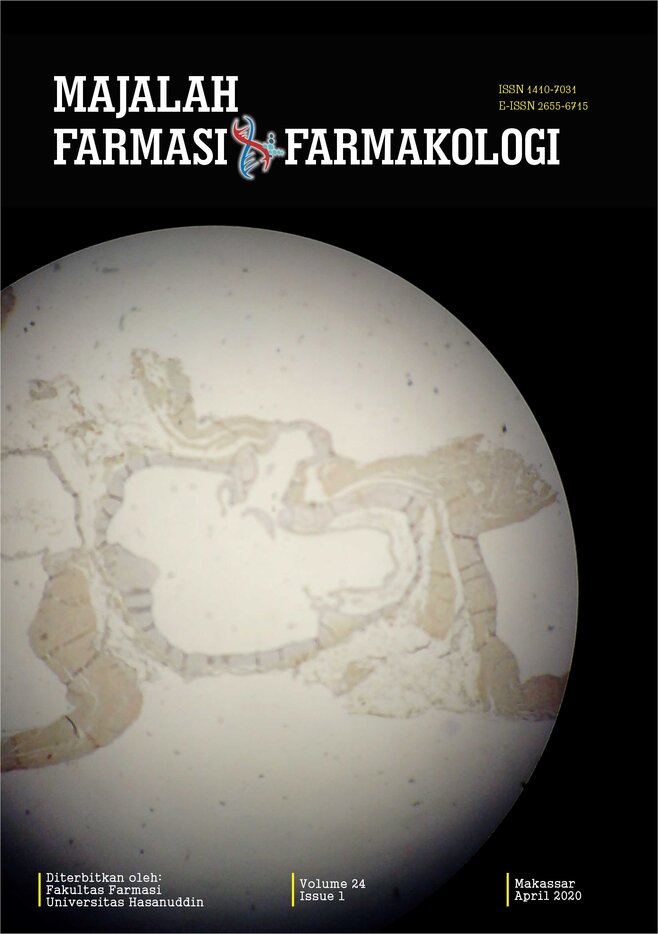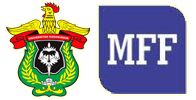ISOLASI ACTINOMYCETES SIMBION SPONGE PULAU BARRANG CADDI MAKASSAR SEBAGAI PENGHASIL SENYAWA ANTIMIKROBA
Abstract
Sponges as a residence for microorganisms make it a High Microbial Abundance Sponge (HMAS) where 40-60% of the biomass of the sponge consists of microorganisms. One of the bacteria that originates from the sea and has long been known to be breed is Actinomycetes. Actinomycetes that are symbiotic with sponges are very numerous and rich in the discovery of new chemotypes with interesting therapeutic activities that are not found in terrestrial organisms. The purpose of this study was to determine the antimicrobial activity of Actinomycetes isolates obtained from Barrang Caddi Island sponges. Actinomycetes isolation was carried out by pour and spread plate methods. From seven isolates actinomycetes obtained from sponge collections from Barrang Caddi Island, Makassar City, South Sulawesi are able to inhibit test microbes in initial screening with antagonistic test.
References
Abdelmohsen, U. R., Chen, Y., Hannes, H., Dina, H., Timothy, R. and Ute, H. 2014. ‘Actinomycetes from red sea sponges: Sources for chemical and phylogenetic diversity’, Marine Drugs, 12(5), pp. 2771–2789. doi: 10.3390/md12052771.
Abdelmohsen, U. R., Bayer, K. and Hentschel, U. 2014. ‘Diversity, abundance and natural products of marine sponge-associated actinomycetes’, Natural Product Reports, 31(3), pp. 381–399. doi: 10.1039/c3np70111e.
Kane, S. N., Mishra, A. and Dutta, A. K. 2016. ‘Preface: International Conference on Recent Trends in Physics (ICRTP 2016)’, Journal of Physics: Conference Series, 755(1). doi: 10.1088/1742-6596/755/1/011001.
Kodzius, R. and Gojobori, T. 2015. ‘Marine metagenomics as a source for bioprospecting’, Marine Genomics. Elsevier B.V., 24, pp. 21–30. doi: 10.1016/j.margen.2015.07.001.
Lacey,J., 1997, Actinomycetes in Compost. Annals, Agr. Environ.Med, 4,113
Murniasih, T. 2003. ‘Metabolit Sekunder dari Spons sebagai Bahan Obat-Obatan’, Jurnal Oseana, 28(3), pp. 27–33. doi: 10.1093/bmb/ldw024.
Madigan,M.T., Martinko,J.M., Parker,J., 2003, Brock Biology of icroorganisms,10 ed., Pearson Education Inc. USA
Rante, H., Wahyono,. Yosi, B.M., and Gemini A. 2010. ‘Purifikasi dan karakterisasi senyawa anti- bakteri dari actinomycetes asosiasi spons terhadap bakteri patogen resisten’, Majalah Farmasi Indonesia, 21(3), pp. 158–165.
Sheik, G. B., Muazzam, S. M., Ghokul, S.S., and Ranjith, M.S. 2017. ‘Isolation and Characterization of Actinomycetes From Soil of Ad-Dawadmi, Saudi Arabia and Screening Their Antibacterial Activities’, International Journal of Pharmacy and Pharmaceutical Sciences, 9(10), p. 276. doi: 10.22159/ijpps.2017v9i10.15402.
Sulistyani, N. and Akbar, A. N. 2014. ‘Aktivitas Isolat Actinomycetes dari Rumput Laut ( Eucheuma cottonii ) sebagai Penghasil Antibiotik terhadap Staphylococcus aureus dan Escherichia coli’, Jurnal Ilmu Kefarmasian Indonesia, 12(1), pp. 4–12.
Szumowski,S.C., 2008, “Biogeography of microorganisms inhabiting marine sponge”, Macalester Review in Biogeography Vol. 1 Article 4.
Downloads
Published
Issue
Section
License
The copyright to this article is transferred to Universitas Hasanuddin (UNHAS) if and when the article is accepted for publication. The undersigned hereby transfers all rights in and to the paper including without limitation all copyrights to UNHAS. The undersigned hereby represents and warrants that the paper is original and that he/she is the author of the paper, except for material that is clearly identified as to its original source, with permission notices from the copyright owners where required. The undersigned represents that he/she has the power and authority to make and execute this assignment.
We declare that:
- This paper has not been published in the same form elsewhere.
- It will not be submitted anywhere else for publication prior to acceptance/rejection by this Journal.
- A copyright permission is obtained for materials published elsewhere and which require this permission for reproduction.
Furthermore, I/We hereby transfer the unlimited rights of publication of the above-mentioned paper in whole to UNHAS The copyright transfer covers the exclusive right to reproduce and distribute the article, including reprints, translations, photographic reproductions, microform, electronic form (offline, online) or any other reproductions of similar nature.
The corresponding author signs for and accepts responsibility for releasing this material on behalf of any and all co-authors. This agreement is to be signed by at least one of the authors who have obtained the assent of the co-author(s) where applicable. After submission of this agreement signed by the corresponding author, changes of authorship or in the order of the authors listed will not be accepted.


